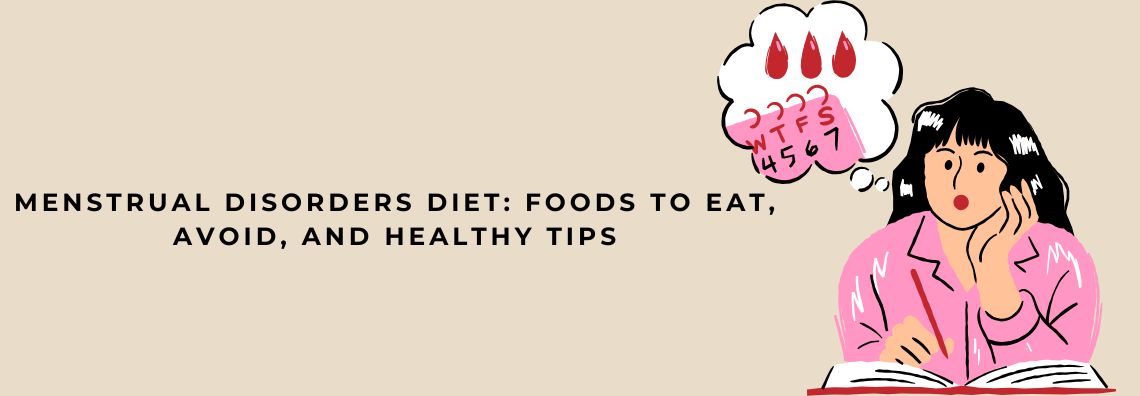
Diet can improve your experience of having periods. A range of benefits follows when you make changes in your diet and routine activities. If you are facing issues in having periods then follow this guide to understand what dietary changes can make your experience better. Also, some food needs to be eliminated so you must pay attention to them.
Here we are with the best foods to eat, food to eliminate and health tips for a better menstrual experience especially if you are facing any menstrual disorders.
Certain menstrual disorders like premenstrual syndrome (PMS) and some cases of irregular periods can be managed or alleviated through dietary adjustments.
Foods To Eat: Deal With Menstrual Disorders
To ease menstrual discomfort and potentially address menstrual disorders focus on a diet rich in iron, calcium, magnesium, omega-3 fatty acids and fibre while limiting salt, caffeine and processed foods.
Calcium
Calcium intake may help alleviate some symptoms of menstrual disorders, particularly those related to premenstrual syndrome (PMS) like mood swings, bloating, and pain, by addressing potential calcium deficiencies.
A calcium-rich diet including foods like dairy, fish with bones and fortified options may help reduce menstrual cramps and other PMS symptoms like bloating and water retention.
Fibre
A fibre-rich diet can help manage menstrual disorders by balancing estrogen levels, aiding digestion and potentially leading to reduced bloating and cramps. Excess estrogen can cause heavy bleeding and painful periods but food rich in fiber including fruits, vegetables, whole grains, nuts and seeds may help.
Fibre promotes healthy bowel movements, which can reduce bloating and discomfort often associated with menstruation. Fibre also helps reduce menstrual cramps by balancing estrogen levels and decreasing inflammation.
Iron
To support iron levels and potentially deal with menstrual disorders, focus on incorporating iron-rich foods like lean meats, beans, leafy greens and fortified cereals in your diet. Consider vitamin C-rich foods to enhance iron absorption.
Iron-rich food sources include meats, legumes, vegetables and nuts. You can include beans, lentils, chickpeas, lean red meat, poultry, fish, bread and pasta to increase iron intake.
Magnesium
A magnesium-rich diet including foods like leafy greens, nuts, seeds and dark chocolate may help alleviate menstrual cramps and other symptoms of menstrual disorders by relaxing muscles and reducing inflammation.
Magnesium helps relax muscles, including the uterus, which can reduce the severity of menstrual cramps. It may help lower levels of prostaglandins, chemicals that cause the uterus to contract and create pain during menstruation.
Omega-3 Fatty Acids
Omega-3 fatty acids especially EPA and DHA found in fish oil, may help reduce menstrual pain and other symptoms of primary dysmenorrhea and premenstrual syndrome (PMS) due to their anti-inflammatory properties. During menstruation, the body releases prostaglandins, which are involved in inflammation and pain. Omega-3s can help reduce the production of these prostaglandins, thus alleviating pain and other symptoms.
Moving forward to the foods to avoid and healthy tips for your menstrual better experience.
Foods To Avoid For Better Menstrual Experience
To minimise discomfort during menstruation, consider avoiding foods high in salt, sugar, caffeine, alcohol and processed foods as these can worsen cramps, bloating and other symptoms. Here are the foods you must avoid:
- High sodium intake can lead to water retention and bloating, which can worsen menstrual discomfort, so, avoid salty foods.
- Sugary foods can trigger blood sugar spikes and crashes, potentially worsening mood swings and cramps.
- Caffeine can contribute to irritability, poor sleep and menstrual cramps.
- Alcohol is highly responsible for dehydration and it can worsen headaches and cause bloating. Digestive issues will also follow if you don’t limit alcohol consumption.
- Are you fond of spicy foods? You need to limit your spicy foods intake because some people find that spicy foods upset their stomachs, causing diarrhoea, stomach pain and nausea.
- Fatty and fried foods can increase inflammation and discomfort.
- Dairy products can sometimes trigger inflammation and worsen menstrual pain, you must consult a specialist for better advice and check-up.
We have learned about the diet, now we will discuss a few tips for your menstrual comfortable experience.
Healthy Tips For Happy Menstruation
For healthier and happier menstruation, focus on a balanced diet, and regular exercise. Good sleep is indeed needed as you need to manage stress for proper health. Here are the tips for your happy menstruation:
- Engaging in regular physical activity, even light exercise like walking can help improve mood, reduce cramps, and boost energy levels. During your period, focus on gentle activities like stretching or yoga.
- Aim for 7-8 hours of quality sleep each night, as sleep deprivation can worsen PMS symptoms.
- Practice stress-reducing techniques like yoga, meditation, or deep breathing to help regulate hormones and reduce mood swings.
- If you have any concerns about your menstrual cycle or experience unusual symptoms, consult with a healthcare professional.
- Proper sanitation and disposal are a must in your menstruation hygiene.
Visit a specialist for concerns regarding PCOS and others. A PCOS specialist can help you manage irregular periods, acne and excessive hair growth.